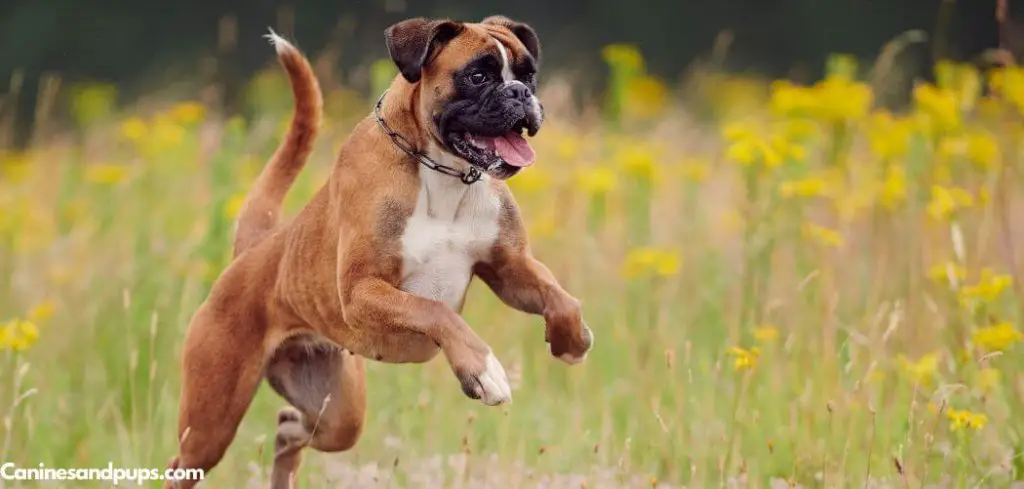Dogs that are panting and jumpy can be energetic, playful, or sometimes stressed, but these behaviors can also signal underlying health or emotional issues.
While panting is a normal way for dogs to regulate body temperature, excessive panting paired with restlessness or jumpiness can sometimes indicate anxiety, excitement, or a medical concern.
We outline the common reasons for panting and being jumpy in dogs, what you can do, and when to seek veterinary help.
Dog Panting and Jumpy — Why It Happens
Dog panting and being jumpy often occur when a dog is anxious, overstimulated, or frightened. Panting is a stress response that helps the body release tension and regulate temperature, while jumpiness reflects a heightened state of alertness or fear.
Common triggers include loud noises, unfamiliar environments, sudden movements, or past trauma. In some cases, pain, hormonal imbalances, or neurological issues can also cause this behavior.

Dog Panting and Jumpy: Common Causes
Normal Excitement and Playfulness
Panting while jumpy is often a normal response to excitement and play. Dogs naturally express energy through movement and vocalizations, and panting helps them cool down during active periods.
This behavior is usually temporary and subsides once the dog calms down. Puppies and young dogs often exhibit this more frequently due to high energy levels.
Read more: Dog Panting and Running Around (Normal vs excessive behavior)
Anxiety or Nervousness
Some dogs pant and appear jumpy due to anxiety or nervous energy. Panting is a physiological response to increased stress hormones, while jumpy movements can be a way to release tension.
Triggers can include new environments, loud noises, separation from their owner, or unfamiliar people or animals. Dogs may pace, shake, or display other signs of stress alongside panting.
Overstimulation
Excessive stimuli can lead to panting and jumpiness. A dog exposed to continuous excitement, loud sounds, or chaotic environments may react by panting heavily and becoming hyperactive.
Owners may notice repetitive movements, barking, or difficulty settling down. Reducing environmental stressors and providing calm spaces can help mitigate this behavior.
Pain or Discomfort
Unexpected jumpiness paired with panting may indicate pain or discomfort. Dogs sometimes become restless when experiencing discomfort, moving or jumping as a coping mechanism.
Signs of pain may include whimpering, favoring one side of the body, reluctance to lie down, or sudden aggression. Early recognition is crucial to prevent worsening of the underlying condition.
Medical Conditions Affecting Heart or Respiratory Function
Panting disproportionate to activity and jumpiness can signal heart or respiratory issues.
Dogs with cardiovascular strain or breathing difficulties may display restlessness and rapid panting.
Other signs may include coughing, fatigue, difficulty lying down comfortably, or a rapid heartbeat. A veterinary evaluation is essential to rule out serious medical causes.
Hyperthyroidism or Metabolic Disorders
Metabolic conditions can lead to increased energy and panting. Dogs with overactive thyroid glands or other metabolic issues may appear jumpy, restless, and pant excessively even with minimal activity.
Weight loss, increased appetite, and behavioral changes often accompany these conditions. Proper diagnosis and management by a veterinarian are necessary for controlling symptoms.
What to Do If Your Dog Is Panting and Jumpy
Provide a safe and calm environment to help your dog regulate energy levels. Avoid overstimulating situations, and ensure access to fresh water and a comfortable space to rest.
Establish consistent routines for exercise and play. Regular mental and physical stimulation can help reduce jumpiness caused by excess energy or boredom.
Monitor your dog for signs of stress, anxiety, or pain. If jumpiness persists with heavy panting, allow your dog to rest and evaluate whether medical attention is necessary.
Positive reinforcement training and interactive toys can help redirect nervous or hyperactive energy. Over time, this can reduce the frequency and intensity of jumpy behavior.
Observe for sudden changes in behavior or breathing patterns. Restlessness or panting that is unusual for your dog may require veterinary attention to rule out underlying health problems.
When to Call or Visit Your Vet
Seek veterinary help if your dog exhibits:
Panting that is excessive, persistent, or disproportionate to activity
Continuous jumpiness or restlessness with no apparent trigger
Signs of pain, including whimpering, favoring limbs, or reluctance to lie down
Rapid heartbeat, labored breathing, or coughing alongside panting
Sudden behavioral changes such as aggression, disorientation, or collapse
Veterinarians can perform a physical exam, diagnostic tests, and blood work to determine whether medical conditions are contributing to panting and jumpy behavior.
Read more: Dog Panting and Following Me Around (Here’s why)
Key Takeaway
Panting combined with jumpiness is often normal, especially during play or excitement, but when it becomes excessive, persistent, or paired with unusual behavior, it may indicate stress, medical issues, or discomfort.
Providing a calm environment, regular exercise, mental stimulation, and monitoring your dog’s behavior can help maintain a healthy balance.
Seek veterinary guidance if panting or jumpiness seems abnormal to ensure your dog remains happy, healthy, and safe.
